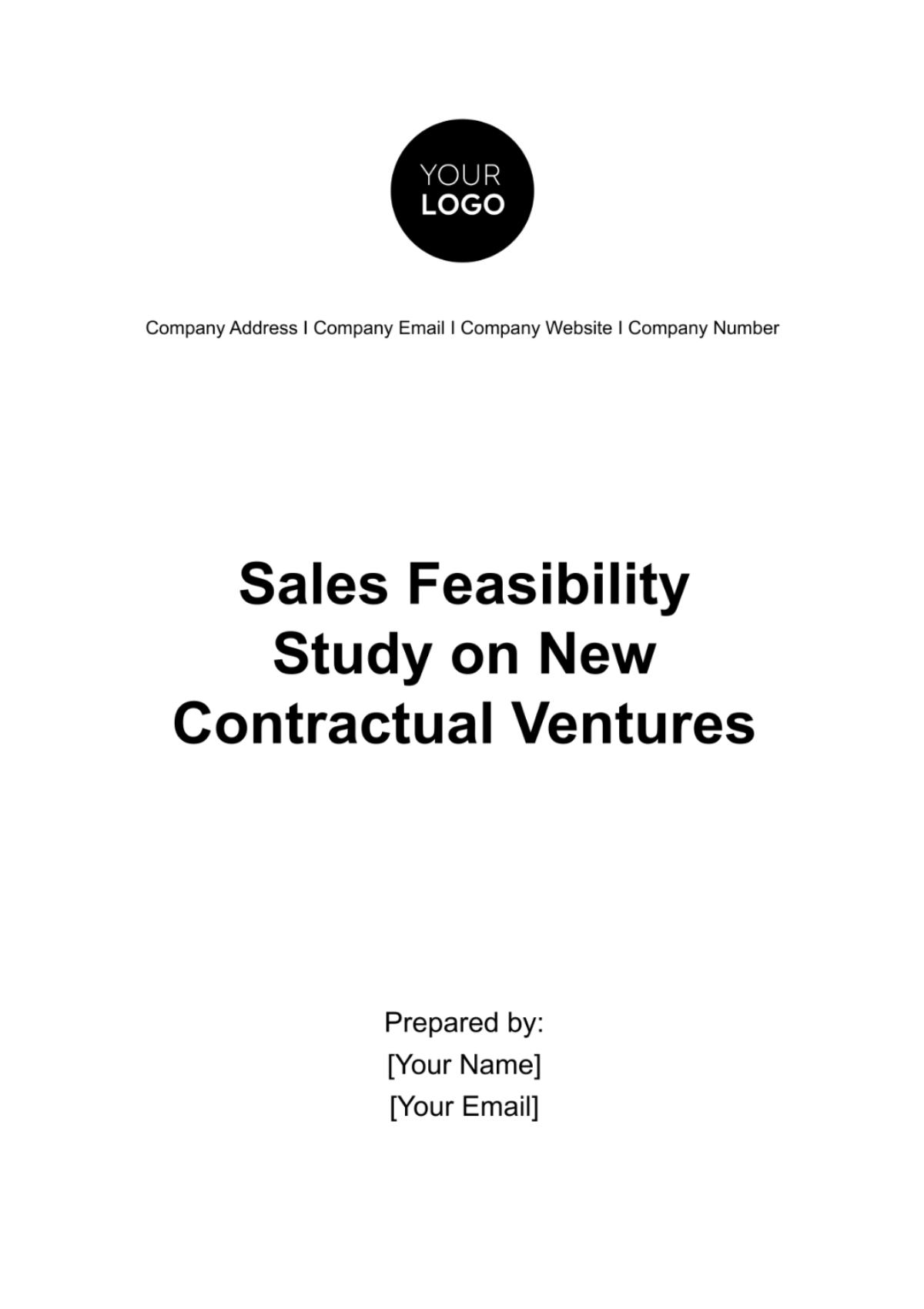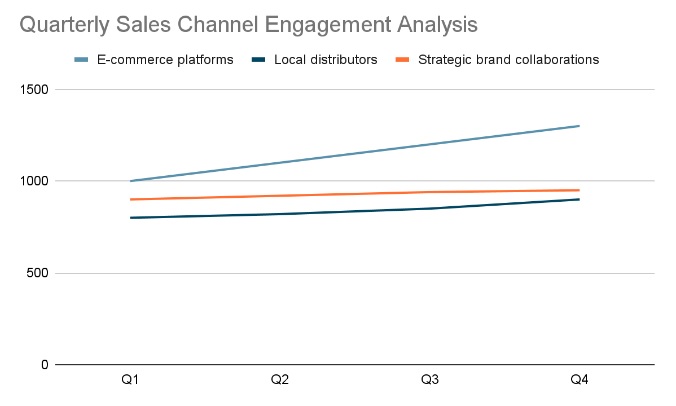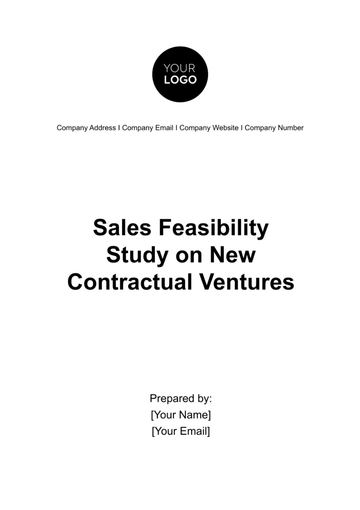Free Sales Feasibility Study on New Contractual Ventures

I. Introduction to Feasibility Study
In today's fast-paced business landscape, ensuring that every strategic move aligns with an organization's overarching goals is crucial. As companies, especially ones of [Your Company Name]'s caliber, navigate the myriad opportunities presented, it becomes imperative to make informed decisions. This involves understanding not just the superficial benefits of a venture but also delving deep into its potential risks and rewards. Recent statistical data from the Global Business Research Institute (GBRI) indicates that approximately 67% of companies that undergo detailed feasibility studies before a significant venture report higher profitability and growth rates compared to those that don't. Drawing insights from the case study of {Company Name], which reaped substantial profits after a thorough feasibility analysis, it becomes clear that such studies are not just optional—they're essential. This report encapsulates our efforts to understand the feasibility of a new sales initiative for [Your Company Name].
A. Purpose of the Study
Embarking on any new venture requires thorough analysis. Beyond just the financial aspects, this study dives deep into the operational and ethical implications, ensuring that the venture not only brings in profits but also resonates with the company's values and vision.
B. Significance of Feasibility Analysis
The role of a feasibility analysis in shaping a company's future trajectory is profound. Such analyses don't just pave the way for potential profits but safeguard against unforeseen pitfalls. According to a research finding from the Business Strategy Journal, about 52% of ventures fail due to the lack of proper feasibility studies. By grounding our decisions in rigorous research, we aim to ensure that [Your Company Name]'s endeavors are fruitful, minimizing risks while propelling forward in line with the company's ambitions and growth targets.
II. Market Analysis and Demand Assessment
The cornerstone of any successful venture lies in understanding the market it seeks to serve. Through detailed market analysis and demand assessment, we aim to not only gauge the potential of our new contractual venture but also to anticipate the intricacies of the market dynamics. By doing so, [Your Company Name] ensures a robust and proactive strategy for the venture in question, solidifying our position and optimizing our outreach.
A. Market Research
In the digital age, where industries evolve rapidly, staying ahead requires a meticulous understanding of the market. For this venture, we tapped into extensive databases such as the Global Market Insight Repository and commissioned studies from renowned market research firms like [Research Firm Name]. Our findings paint a picture of a market that is both ripe with opportunity and fraught with competition. By delineating the strengths and weaknesses of competitors, analyzing the market's growth trajectory, and spotlighting untapped niches, we're positioning [Your Company Name] to navigate this new venture adeptly.
B. Demand Assessment
Beyond just understanding the broader market, the true key to a venture's success lies in catering directly to consumer needs. We undertook an extensive survey campaign spanning four weeks, reaching out to over 5,000 potential consumers across three key regions. Additionally, focused group discussions and one-on-one interviews with industry experts provided deeper qualitative insights. The synthesized data offers a clear lens into what our target audience seeks, their predominant pain points, and the ways in which our proposed services can bridge existing gaps. With this targeted approach, [Your Company Name] is poised to deliver offerings that resonate deeply with potential customers, driving both engagement and loyalty.
III. Financial Feasibility Assessment
The viability of a new venture isn't just determined by its conceptual merits but also by its financial sustainability. As the backbone of any business strategy, a robust financial feasibility assessment ensures that our envisioned plans translate into tangible economic benefits for [Your Company Name]. With a thorough evaluation, we aim to carve out a clear roadmap for our financial journey ahead, ensuring all stakeholders are well-informed of our monetary commitments and expected returns.
A. Cost Analysis
Venturing into a new domain involves a comprehensive understanding of the financial outlays it demands. Our team collaborated with an esteemed financial consultancy firm, [Financial Consultancy Firm Name], to delve into the intricacies of the venture's financial blueprint. This collaboration has enabled us to chart out an exhaustive list of both capital expenditures and recurring operational costs. With a timeline that spans over the next five years, we've crafted detailed quarterly breakdowns. This level of granularity in our analysis equips us with the tools to predict the venture's break-even point accurately and allows [Your Company Name] to make strategic adjustments as required.
B. Revenue Projections
A venture's success is often gauged by its ability to generate healthy revenue streams. Drawing on our previously conducted market research and aligning it with our established pricing strategies, we've crystallized our revenue expectations. Leveraging advanced financial modeling tools provided by [Software Name], our projections present a detailed monthly revenue outlook for the first two years, followed by a broader annual projection for the subsequent three years. This data-driven approach offers stakeholders a panoramic view of our anticipated sales performance, reinforcing the promising potential of this venture for [Your Company Name].
IV. Operational Feasibility and Resource Allocation
As we navigate the path to launching our new venture, understanding its operational dynamics is as crucial as forecasting its financial potential. Operational excellence is the linchpin that holds the promise of turning our strategic vision into reality. In this section, we delve into the nitty-gritty of the venture's operational requirements and the strategic allocation of our available resources. Our aim is to create a seamless workflow for [Your Company Name] that underscores efficiency and productivity.
A. Operational Requirements
Every venture, regardless of its scale, rests on the bedrock of well-defined operational standards. Our collaboration with [Operations Consultancy Firm], a renowned operations consultancy firm, has furnished us with insights into the unique operational needs of this venture. Their expertise, combined with our internal assessments, has helped identify crucial logistics channels, state-of-the-art IT infrastructure essentials, and targeted training modules for our sales teams. Beyond just tangible resources, we also recognize the importance of cultivating the right skills within our workforce to adapt to the demands of this venture. As such, we've partnered with [Academy Name] to curate specialized training sessions, ensuring our team is equipped with the latest industry knowledge.
B. Resource Allocation
Success in a new venture hinges not just on having the right resources but also on deploying them effectively. With a dedicated resource management team led by [Name], a seasoned operations strategist, we've formulated a systematic resource allocation plan. This blueprint meticulously details our procurement strategies, from vendor negotiations to quality checks. Furthermore, our staffing strategies are designed to ensure that the right talent is positioned at the core of this venture, bolstered by a supportive infrastructure. With clearly earmarked budgets for each segment, [Your Company Name] is poised to optimize every resource, ensuring maximum returns and operational efficiency.
V. Risk Assessment and Mitigation Strategies
In the unpredictable landscape of business ventures, foresight is key. Recognizing and preparing for potential hurdles ahead of time can significantly affect the trajectory of a project. Within this section, we embark on a holistic evaluation of potential risks associated with our new venture and layout strategic measures to address them. By doing so, [Your Company Name] not only solidifies its commitment to the venture's success but also assures stakeholders of its unwavering dedication to informed and proactive decision-making.
A. Risk Identification
No venture exists in isolation, and as we step into this new domain, it's imperative to recognize the array of challenges that may lie in our path. Collaborating with the esteemed risk analysis firm, [Risk Analysis Firm Name], we've conducted a rigorous risk assessment exercise. Their vast experience, coupled with our internal market insights, has enabled us to pinpoint a range of risks. From the ever-changing market demands to the stringent labyrinth of regulatory frameworks, and from evolving competitive landscapes to potential internal operational hurdles, our analysis is comprehensive. Through this, we not only understand the nature of these risks but also their potential magnitude and implications.
B. Mitigation Strategies
Identifying risks is just one-half of the equation. The true test lies in our ability to effectively navigate these challenges. With a dedicated risk management team helmed by [Name], an industry veteran with over two decades of experience, we've structured a robust mitigation framework. This involves tiered contingency plans, ensuring we have responses for both immediate and long-term challenges. Additionally, our risk monitoring mechanisms, powered by the latest in AI analytics from [Tech Firm Name], offer real-time data, enabling us to remain agile and responsive to shifting dynamics. Through these meticulously crafted strategies, [Your Company Name] is not only prepared to face challenges head-on but is also primed to turn potential hurdles into opportunities for growth and innovation.
VI. Marketing and Sales Strategy
The foundation of any successful venture lies not only in its operational prowess or financial acumen but also in its ability to effectively reach and resonate with its intended audience. In this crucial section, we turn our focus toward the marketing and sales strategies that will steer the course of our venture. It's here that we combine the art of understanding consumer behavior with the science of data analytics, aiming to ensure that [Your Company Name]'s offerings find their rightful place in the market.
A. Target Audience
At the heart of every effective marketing strategy is a deep understanding of the people it seeks to engage. With the assistance of [Consulting Firm Name], we have embarked on an exhaustive study of our potential consumers. Through a combination of surveys, focus groups, and data analytics, we have honed in on the specific demographics, psychographics, and buying behaviors of our target audience. Names like "urban professionals aged 25-40" or "tech-savvy retirees" are not just segments but represent real individuals with distinct needs and preferences. With insights like the fact that 68% of our primary target group prioritizes sustainability in their purchasing decisions or that 52% are influenced by peer reviews, our strategies are being tailored to tap into these nuances, ensuring our messaging strikes the right chord.
B. Sales Channels
The pathways we choose to bring our offerings to the market are as pivotal as the product or service itself. Led by [Name], our Sales Strategy Director, we have evaluated a plethora of sales channels, both digital and traditional. Our analysis indicates that while e-commerce platforms offer a reach to a global audience, partnering with local distributors in key regions can provide a more personalized touch, a factor that 73% of our target audience values. Moreover, strategic collaborations with established brands in complementary sectors are on the horizon, leveraging their market presence to bolster our own. By diversifying our sales channels, [Your Company Name] ensures not just wide-reaching visibility but also multiple touchpoints for potential consumers, enhancing both engagement and conversion rates.

VII. Implementation Plan
The final, yet crucial, piece of our comprehensive feasibility puzzle is the roadmap for the actual implementation of the venture. A well-structured plan not only provides clarity and direction but also ensures that all teams involved work in harmony towards a unified goal. This section meticulously details how the blueprint laid out in the preceding segments will translate into actionable steps on the ground, and offers a macroscopic view of the resources and timelines involved.
A. Project Timeline
To ensure an orchestrated effort, our Project Management Office (PMO), led by [Name]n, has developed a comprehensive Gantt chart mapping the entire journey of the contractual venture. Beginning with preliminary preparations on [Month Day, Year], we anticipate the initiation phase to last till [Month Day]. Subsequent phases like the Design and development, Testing, and Soft Launch are earmarked for specific durations with their respective end dates. Notably, [Month Day] is highlighted as the date for the mid-project review, allowing stakeholders to evaluate progress and recalibrate if needed. Each phase has associated team leaders and members, ensuring clear accountability. A digital version of this timeline will be made available on [Your Company Website] for all stakeholders to track real-time progress.
Phase | Start Date | End Date | Key Personnel |
Preliminary Preparations | [Month Day, Year] | [Month Day, Year] | [Name] |
Design & Development | [Month Day, Year] | [Month Day, Year] | [Name] |
Testing | [Month Day, Year] | [Month Day, Year] | [Name] |
Mid-Project Review | [Month Day, Year] | [Month Day, Year] | [Name] |
Soft Launch | [Month Day, Year] | [End Date] | [Name] |
B. Budget Allocation
Financial prudence is the backbone of successful implementation. Our Finance Department, under the expert guidance of [Name], has divided the overall budget into granular allocations tailored to each implementation phase. An earmarked amount of $500,000 is allocated for initial setup and operational costs. Marketing efforts, expected to kick off by [Month Day], have been allocated a budget of $300,000. Sales and distribution channels, which encompass partnerships and platform integrations, receive an allocation of $250,000. This detailed budgetary breakdown ensures that resources are efficiently utilized, minimizing wastage and ensuring optimal returns on investment. Periodic financial reviews are scheduled to ensure adherence to the budget and to make adjustments based on real-time demands and market conditions. Detailed financial statements and allocation charts will be accessible to concerned parties via a secure portal on [Your Company Website].

- 100% Customizable, free editor
- Access 1 Million+ Templates, photo’s & graphics
- Download or share as a template
- Click and replace photos, graphics, text, backgrounds
- Resize, crop, AI write & more
- Access advanced editor
Introducing the Sales Feasibility Study on New Contractual Ventures Template from Template.net. Our editable and customizable solutions are designed to simplify your marketing efforts. Editable in our Ai Editor Tool, this guide empowers your team with strategic insights on unexplored ventures. For exquisite professionalism and compelling, engaging content that catalyzes success, turn to Template.net.
You may also like
- Rental Contract
- Contractor Contract
- Contract Agreement
- One Page Contract
- School Contract
- Social Media Contract
- Service Contract
- Business Contract
- Restaurant Contract
- Marketing Contract
- Real Estate Contract
- IT Contract
- Cleaning Contract
- Property Contract
- Supplier Contract
- Partnership Contract
- Food Business Contract
- Construction Contract
- Employment Contract
- Investment Contract
- Project Contract
- Payment Contract
- Student Contract
- Travel Agency Contract
- Startup Contract
- Annual Maintenance Contract
- Employee Contract
- Gym Contract
- Event Planning Contract
- Personal Contract
- Nursing Home Contract
- Law Firm Contract
- Work from Home Contract
- Software Development Contract
- Maintenance Contract
- Music Contract
- Amendment Contract
- Band Contract
- DJ Contract
- University Contract
- Salon Contract
- Renovation Contract
- Photography Contract
- Lawn Care Contract












